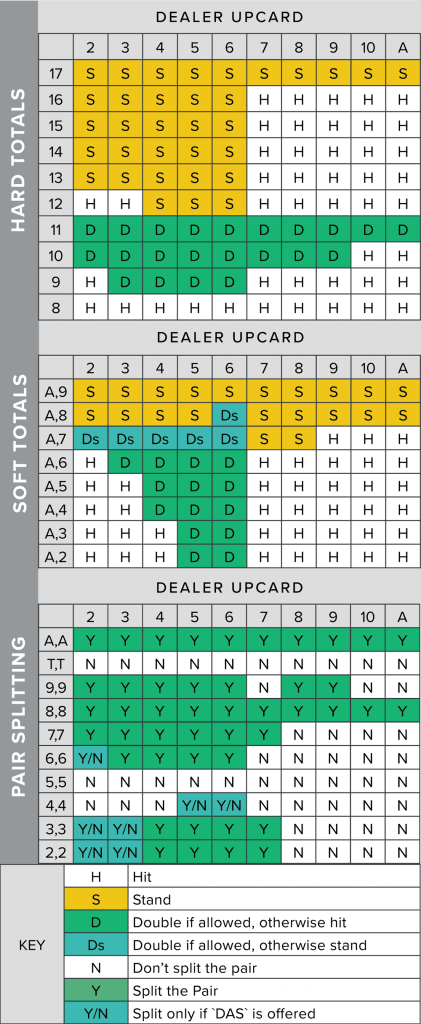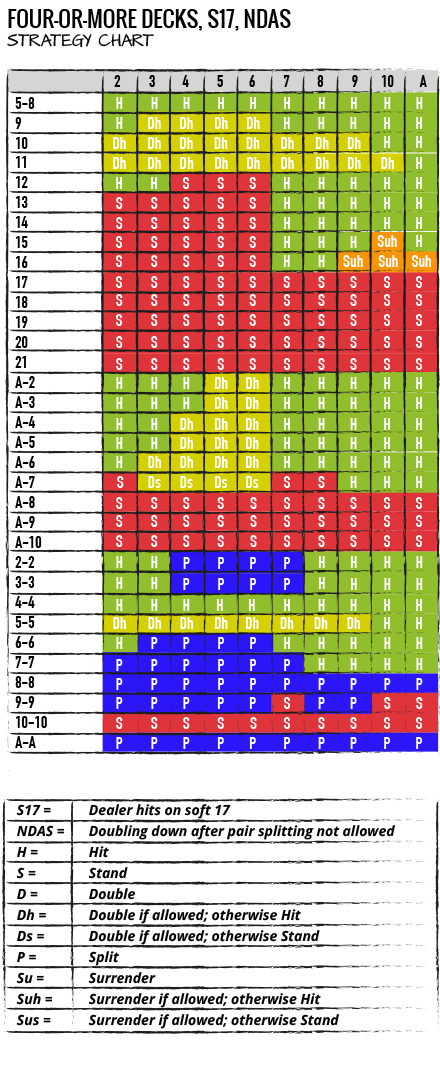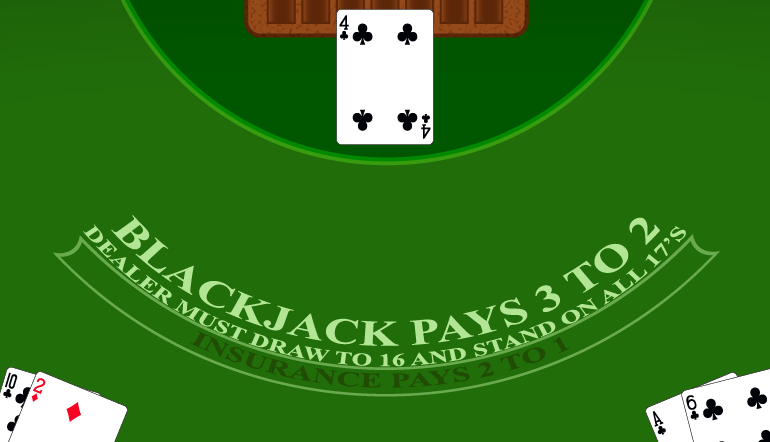Dealer Upcard
In card games, hole carding is the obtaining of knowledge of cards that are supposed to be hidden from view. The term is usually applied to blackjack but can apply to other games with hidden hole cards, like three card poker and Caribbean stud poker. So long as it does not involve the use of a device like a mirror or actions like touching the dealer's cards, in most jurisdictions hole carding is a legal form of advantage gambling in casino table games. In other games, like stud poker, casinos normally have rules against rubbernecking or having a confederate stand behind an opponent to signal hole cards.
Blackjack players must usually make playing decisions based on only seeing one of the dealer's cards (the upcard). But if the dealer's hole card is spotted, a player who plays correctly has a theoretical advantage of up to 13% instead of the normal player disadvantage of around 0.5%. A hole-card player will often choose not to make certain plays, such as hitting a hard 19 against a dealer 20, so as not to reveal that he can see the dealer's hole card.
This technique is not applicable in most games outside of the United States where the second dealer card is normally not dealt until all players have played.
But the dealer upcard is nearly as important. Here we will look a bit deeper by including the dealer upcard. As there are ten possible upcards, there are 340 possible initial two-card hands and dealer upcard. These charts are more complex and require three dimensions. As in the previous charts, the x-axis shows each of the 34 initial two card.
Strategies[edit]

A normal blackjack strategy has ten columns, for an ace through dealer ten value card. Strategy tables for hole carding differ from normal blackjack tables as they include a column for each possible total dealer hand instead of simply the visible card. Below is a sample hole card hit/stand table for six decks, stand on soft-17. The columns are based on the dealer hand and the rows based on the player hand. Green denotes a hit.
- Blackjack Dealer Outcome Probabilities The dealer outcome probability charts on this page can be helpful in determining which of two tournament strategies is preferable. The values in these charts were calculated using a combinatorial analysis from a full deck after removing only the dealer’s upcard.
- The player to dealer's left must start by flipping cards until able to beat this card, before beginning the first round of betting. Some play with back betting. When a player flips all seven cards without beating the best hand, and is thereby knocked out, there is a round of betting begun by the best hand showing before the next player begins.
First-basing and spooking[edit]
One method of hole carding is to peek at the card when the dealer checks the hole card for blackjack. This is called 'first-basing'.[1] A modification called 'spooking' refers to a partner with a better view peeking at the hole card in the same circumstance and communicating the information to the player. Peeking devices have made these methods largely obsolete.[2]
Front-loading[edit]
Front-loading refers to observing the hole card as it is slid under the upcard.[3] Newer methods of hole-carding concentrate on observation before the down card is placed under the upcard. This provides information about the card even if the dealer upcard is not a ten or an ace. The advantage varies depending on the rules, the percentage of cards seen, and the strategies used.
Partial information[edit]
At times the player will see a corner of the hole card, but not enough to determine the exact card. For example, if there is no pip in the corner, the card may be an ace, 2 or 3. Or, if there is a pip in the corner, it is a 4-10, but not a face card. To make use of this additional information, a different set of strategy tables must be used depending on the set of possible cards in the hole.[4]
Dealers Up Card
Below is a sample blackjack, partial hole card hit/stand table for two decks. The columns are based on the dealer upcard and the rows based on the player hand. Partial hole card tables contain ten columns as the dealer's total hand is not known with complete certainty. A different set of tables must be used depending on the information acquired from the hole card. In this table, the hole card is a six or seven. Green denotes a hit. One might note that this table bears little resemblance to standard blackjack strategy.
Next card play[edit]
Hole carding generally refers to knowing the dealer’s hole card. Next card play refers to knowing the next card to be dealt. If a round has not started, and a player knows what his or her first card will be, one can simply alter one's bet depending on the value of that card. In a game like blackjack, if the dealer has already dealt a player's first two cards, and the player knows the next card to be dealt, it becomes possible for playing decisions to be altered to include this additional information.[4]:255 Strategies are significantly more complex as there exists a different strategy table for each possible next card. Strategies may also differ depending on a player's position in the dealing rotation:
- First Seat – If the player does not take the known card, another player gets it.
- Last Seat – If the player does not take the card, the dealer may draw it. This also applies in a situation where no player to one's left is likely to draw a card.
- No hole card – In a no-hole-card game, if the player does not take the card, it may become the dealer’s second card.
Other methods[edit]
- Warped cards – In a casino where a blackjack dealer bends the hole card to check for a blackjack, the cards can become warped. The warps can be later used to determine the value of a face down card. This method is largely obsolete as most casinos use devices instead of bending cards to determine dealer blackjacks, and cards are regularly replaced with new decks.[5]
- Dealer tells – When a blackjack dealer checks for a blackjack, some dealers may give clues as to the value of the down card, akin to poker tells. Again, most casinos now use devices to check the down card, rendering this obsolete in most casinos.[6]
- Peeking at other players' cards – Depending on the game and casino, this may or may not be acceptable and may aid player decisions.
- Counting by inference – In blackjack where player cards are dealt face down, the actions of other players can provide clues as to their hidden cards. This is less valuable in modern casinos due to the fewer number of single-deck games and reduction in penetration (how deeply the dealer deals before shuffling.)

Notes[edit]
- ^Blaine, Rick. Blackjack blueprint : how to play like a pro-- part-time. Huntington Press. p. 154. ISBN0-929712-16-1.
- ^Snyder, Arnold. The big book of blackjack (1st ed.). Cardoza Pub. p. 311. ISBN1-58042-155-5.
- ^Uston, Ken. Million dollar blackjack (6th rev. print ed.). Gambling Times. p. 197. ISBN0-89746-068-5.
- ^ abGrosjean, James. Exhibit CAA : beyond counting (1st ed.). South Side Advantage Press, LLC. p. 279. ISBN0-9790061-4-7.
- ^Humble, Lance; Cooper, Carl. The world's greatest blackjack book (Rev. ed.). Doubleday. p. 141. ISBN0-385-15382-1.
- ^Snyder, Arnold (2005). Blackbelt in blackjack : playing 21 as a martial art (3rd ed.). New York: Cardoza Pub. ISBN978-1580421430.
In order to master the game and leave the casino as winners, players should always follow a strategy and prepare themselves in advance for every possible hand they can get. Along with solid knowledge regarding the game’s rules and probabilities, they should also have money management skills and discipline. Moreover, without setting loss limits and win goals, no matter how lucky they get, they are bound to lose everything.
The only way players can make a profit is if they focus on winning in the long term by applying their chosen strategy throughout the game. Even if they get a sequence of losing hands, it is essential not to give up on it as what really matters is to manage to win the majority of the hands, not all of them.
Regardless of what strategy players will choose to follow, their decisions should be always based on the dealer’s up card along with their hand’s total value. It is really important to decide which move is the best according to those two factors as after all players compete against the dealer. Regardless of how obvious this may be, there are still lots of gamblers around the world who constantly misplay their hands due to the fact that they fail to pay the needed attention the up card deserves.
Importance of The Dealer’s Up Card When Choosing a Move
The dealer’s up card along with the players’ two cards are the two things which gamblers should take into account when making a decision. The up card of the dealer gives them valuable information about his position and his chances of winning and shouldn’t be underestimated. Even though there is one more card which is invisible to the players – the hole card, they can still predict to some extend what will be the possible outcomes of a particular situation.
The only time they should take into account the rest of the cards in the desk, including the cards of the other players, is when their chosen strategy is card counting. Apart from this case, there is no need to follow them as the number of the cards from one rank left in the deck doesn’t affect the basic strategy’s odds and probabilities.
| Dealer’s Up Card and Chances of busting | ||
|---|---|---|
| Dealer’s up card | Dealer’s chances of going bust | Advantage of the players with the Basic Strategy |
| 2 | 35.30% | 9.8% |
| 3 | 37.56% | 13.4% |
| 4 | 40.28% | 18.0% |
| 5 | 42.89% | 23.2% |
| 6 | 42.08% | 23.9% |
| 7 | 25.99% | 14.3% |
| 8 | 23.86% | 5.4% |
| 9 | 23.34% | -4.3% |
| 10, J, Q, K | 21.43% | -16.9% |
| A | 11.65% | -16.0% |
Importance of the Dealer’s Up Card When Choosing a Live Casino Table
Dealer Upcard Meaning

As already mentioned above, the dealer’s up card is extremely important as it gives players a general idea of his position during the course of the game. However, the up card of the dealer should be also taken into account even before they become a part of the game. Many professional players know how essential is to take their time to observe the up card of the dealer prior to sitting on the table as this way they have the chance to see whether he is in a weak position or not. This particular card plays a crucial role not only throughout the game but also during the time they choose a table to sit as it allows them to choose one which will give them better chances of winning.
Splitting a Pair of 9’s
Splitting a Pair of 10’s
Dealer’s Up Card
Basic Strategy Money Management
Running True Count
Important Things to Consider When Choosing a Live Casino Table
Dealer Upcard
Regardless of the strategy players have chosen to follow, it is always favourable to start when the dealer’s position is weak. This way they will gain advantage over the casino and their chances of winning will significantly increase. Prior to sitting on a table and playing, it is recommended for players to observe the dealer’s up card in order to determine his situation. It is worth mentioning that they should focus only on it, not on the outcome of his hand.
Also, players should look for tables which have at least two available sits in order to make sure that their time won’t be wasted by observing a table which they cannot join. Even though sometimes it can take a lot of time to find the desired table, they need to remember that all of their efforts won’t be in vain at the end. The best time to join a game is when the dealer is in a weak position or otherwise known as in a cold trend.
Dealer Upcard
What is worth mentioning is that during some point in the game, the dealer’s cards follow a particular trend and this is the thing they should take into account. This trend is a double-edged sword as players who are aware of it can use it in their favour but the ones who are not can put themselves in a very disadvantages position. This is the reason why they should observe the string of cards the dealer has and in case they are power ones, they should refrain themselves from sitting on the table. In this case, competing against the dealer will be hard and also they won’t be able to double down or split which decreases their chances of making extra money significantly.
Determining the Dealer’s Position
Dealer Upcard Chart
When choosing a table, players need to determine the position of the dealer by taking into account his up card. The reason why is that if his up card is a power one, this makes it harder to compete against him and joining the game in such a moment is not the best decision. There are three types of cards in the deck which help players to define his situation.
The power cards are all of the face cards as well as a nine and a ten. They are the ones that give him the biggest advantage as they place him in a favourable position. Respectively, weak cards are the ones from two through six as they have a low card value and reaching twenty one with them is hard. Eight and seven are considered to be neither weak nor strong which makes them neutral.
Conclusion
The up card of the dealer is very important not only during but also before the game. It gives players the chance to determine whether he is on a cold or hot streak. Every small detail in Blackjack can make a huge different from charting the tables to adhering to a strategy strictly. If players manage to improve every single aspect of their performance and do the needed preparation before the game, this can make the difference between winning and losing. It is really important to take their time and determine which table might favour them and which won’t as this will give them an advantage over the casino.